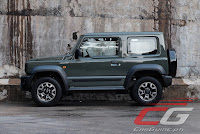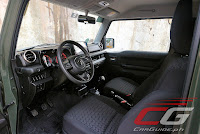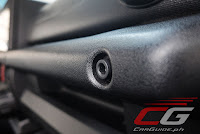Start the Suzuki Jimny and close your eyes. Without a doubt, you’ll find it as one of the most unrefined vehicles in the market today. Have someone drive you around, and the experience will give you motion sickness. It’s bouncy, unrefined, noisy. You’ll be hard-pressed to think why someone would spend a million bucks on one when you can find some other small SUV that’s a better daily than this. Then you open your eyes and you’re smitten. It’s cute and different. Be warned though, it’s not for everyone.
Twenty years has passed since the Jimny has had its first major overhaul, so it’s about right that the “gotta have it factor” starts about three seconds after you stare at the Jungle Green paint job. Compared to a hundred faceless crossover clones out there, this one’s a stand out; like a Mercedes-Benz G-Class, but in 50 percent scale. This, along with retro cues make it instantly desirable. It’s a masterstroke, hypnotizing you to the point that you just had to plop down a non-refundable reservation fee on one even if you haven’t seen it in person, let alone drive it. And that becomes sort of the problem.




See, dismiss the colorful palette of colors and the Jimny’s design should help you set your driving expectations. Look carefully and the non-existent overhangs, unpainted wheel arches, and rear-mounted spare tire become obvious. It does look like a G-Wagen you can purchase from Daiso, but this isn’t an urban crawler. Sure, you can imagine it being driven inside the Ateneo with “A Thousand Miles” blaring through the 2-speaker system (windows down, please), but for the love of God, hopefully it’ll do more than just that. This here isn’t a fashion accessory; it’s a tool, and a pretty good one at that.
Off the beaten path, the Jimny’s simply perfect. The visibility is excellent and the standard All Grip Pro four-wheel drive system with brake-based limited-slip differential means it can haul itself over rutted tracks and even up 38-degree slopes with no difficulty. It even comes standard with hill-hold and descent modes, and a simple-to-use traction control system.
On the road however, it’s another story. The Jimny is a case of what you see is what you get. Underneath, it uses a traditional steel ladder frame chassis. It’s new and stiffer now, but it’s still supporting rigid axles on both ends with separate differentials, and a 1.5-liter 4-cylinder engine with 100 horsepower and 130 Nm of torque. With that, you have to acclimatize to how it drives; failure to do so means questioning your judgement on why you wanted one in the first place.
A few meters are enough to realize this won’t be the most polished driving experience. Though the body structure itself is as solid as a vault, the body control is messy. Turn a corner, and you’ll find that the suspension requires an additional second or two to settle down. Tug it harder, and the result is comical levels of body roll. It doesn’t drive small, since the recirculating ball steering requires more arm twirling action just to get the axles to obey. Clearly, it’s geared to save your thumbs during off-road trails than they are for on-road precision. Still, it’s quite a surprise that the steering never unduly feels lofty and there’s far more front grip than you’d expect. The brakes bite well enough too.




Weighing in at 1,090 kilograms, the it should be more than enough for its larger and more powerful engine (well, at least compared to its predecessor). Yet, this is still a slow car. It doesn’t get off the line quickly, it doesn’t punch through the gears swiftly, and anything approaching 100 km/h is by appointment only. The engine is gruff and gets into a shouting match with the five-speed manual as the revs build. Shame because the box itself is light and mechanically pleasant. The changes can be lengthy, but the gearing is short with 100 km/h hovering around 3,500 rpm at top gear. Surprisingly, despite being bullied by air resistance, 11.62 km/L is not too bad.
The Jimny’s no-nonsense approach continues inside with a dash that’s made of hard plastic. Still, at least they’re solid and feel like it can take a beating for decades to come. In front of the driver are simple, easy-to-read gauges, finished in pods with exposed bolt heads. The same theme runs throughout cabin’s cliff face, and while this normally constitutes shoddy workmanship, here, it’s a well-executed feature.






Try if you insist it on being a five-seater, but the Jimny is purely a 2+2 with ample head- and shoulder room all around. The seats themselves are comfortable enough, but the lack of storage may be a problem for those who tend to carry lots of loose stuff. At the back, the luggage room’s already an improvement from before, but even with that pronouncement, the space is barely enough to fit more than just the Early Warning Device with the rear seats up. Tug on a simple fabric loop though, and the rear seats do fold flat. In short, this will either play the role of a two-seater weekend warrior or a 2+2 city car with no room for excess baggage.
All the negatives concerning its on-road refinement and packaging should serve as a warning: the 2019 Suzuki Jimny isn’t for everyone. There are far better choices out there if all you want is something to take you to and from your pilates or spinning class. Sure, the Jimny can do that, but it can’t do that very well. Instead, it’s meant to cater to the outdoors-type—those who spend their days hiking or biking or visiting construction sites or overlanding. For these people, it comes across as likable despite its on-road haphazardness and packaging compromises.
You can be attracted to it for the way it looks and maybe even its affordable price tag, but there’s a higher level of involvement needed to appreciate what it is and what it can do. It looks fashionable, but in the end, it wears the same Gore-Tex lined clothing and waterproof boots it always has; for that it takes a deeper kind of love and appreciation.
2019 Suzuki Jimny GL M/T |
|
| Ownership | 2019 Suzuki Jimny GL M/T |
| Year Introduced | 2019 |
| Vehicle Classification | Sub-Compact SUV |
| Warranty | 3 years / 100,000 kilometers |
| The Basics |
| Body Type | 3-door SUV |
| Seating | 2+2 |
| Engine / Drive | F/4WD, Part-Time, High/Low, Locking |
| Under the Hood |
| Displacement (liters) | 1.5 |
| Aspiration | Normally Aspirated |
| Fuel Delivery | EFI |
| Layout / # of Cylinders | 4 |
| BHP @ rpm | 100 @ 6,000 |
| Nm @ rpm | 130 @ 4,000 |
| Fuel / Min. Octane | Gasoline / 91~ |
| Transmission | 5 MT |
| Cruise Control | No |
| Fuel Economy @ Ave. Speed | 11.62 km/L @ 18 km/h |
| Dimensions and Weights |
| Length (mm) | 3,650 |
| Width (mm) | 1,645 |
| Height (mm) | 1,725 |
| Wheelbase (mm) | 2,250 |
| Curb Weight (kg) | 1,090 |
| Suspension and Tires |
| Front Suspension | 3-Link, Coil Spring |
| Rear Suspension | 3-Link, Coil Spring |
| Front Brakes | Vented Disc |
| Rear Brakes | Drum |
| Tires | Dunlop Grandtrek AT20 195/80 R 15 S (f & r) |
| Wheels | Alloy |
| Safety Features |
| Airbags | 2 |
| Anti-Lock Brakes (ABS) | Yes, with EBD |
| Traction / Stability Control | Yes |
| Parking Sensors | Yes, Rear |
| Front Seatbelts | 3-pt ELR with pre-tensioner x 2 |
| Rear Seatbelts | 3-pt ELR x 2 |
| ISOFIX Child Seat Anchor | Yes |
| Other Safety Features | Hill Start Assist
Hill Hold Assist |
| Exterior Features |
| Headlights | Halogen |
| Fog Lamps | Yes |
| Auto Lights | No |
| Rain-sensing Wipers | No |
| Interior Features |
| Steering Wheel Adjust | Tilt |
| Steering Wheel Material | Urethane |
| Seating Adjustment (driver) | Manual, 4-way |
| Seating Adjustment (front passenger) | Manual, 4-way |
| Seating Surface | Fabric |
| Folding Rear Seat | Yes, 50/50 |
| On-Board Computer | Yes |
| Convenience Features |
| Power Steering | Yes |
| Power Door Locks | Yes |
| Power Windows | Yes |
| Power Mirrors | Yes |
| Proximity Key | No |
| Climate Control | Manual |
| Audio System | Stereo
MP3
USB
Bluetooth
GPS
Mirror Link |
| # of Speakers | 2 |
| Steering Controls | Yes |




















































